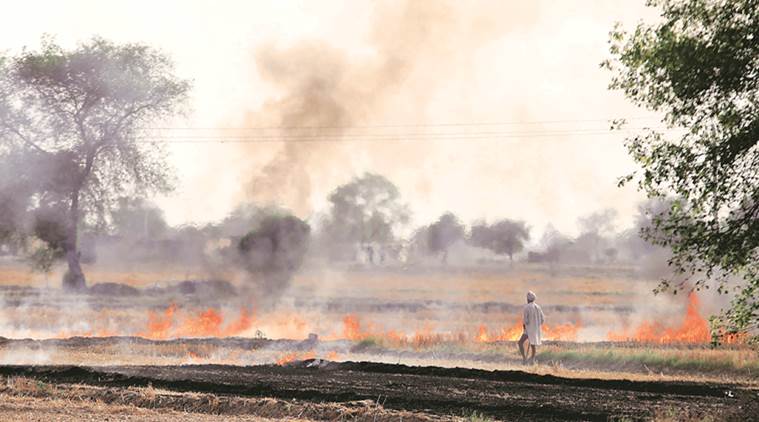IndiaWilds Newsletter Vol. 12 Issue XI
ISSN 2394 – 6946
Farmhouse & Conservation: Need a Holistic Perspective
2020 has been an unprecedented year. COVID 19 pandemic has turned the world topsy turvy. More than 1.4 million people have died worldwide till date and more than 135000 people have died in India. And still the pandemic rages on.
Huge number of people migrated from cities to their villages during the Covid-19 induced lockdown. Majority of the staff of IT companies are working from home. So are teachers and students of schools and colleges. Various Government offices and private sector companies are working at reduced capacity. Many people have lost their jobs. In these unprecedented times as people have been forcibly confined indoors and simultaneously come face to face with death as well as loss in earnings, there has been lot of internal churning in people. Many people have been looking at life differently. Some have changed professions. ( https://www.wsj.com/articles/pandemic-new-platforms-prompt-surge-in-new-therapists-11601816400 )
Moving from City to Farming in Rural India:
A lot of middle class people are looking to go back to their villages and start farming. Some who don’t have any background in farming are also keen at acquiring land for farm houses and staying and earning their livelihoods away from the pollution and stressed lifestyles that our city life has been associated with. However they forget to change their habits.
We humans are slaves of habit. We try to do everything in the same manner as we had done before. We want to change things to suit the way we have lived our life till date. It is not a recent way of thinking. In the past the British introduced exotic weed Lantana camara in India as a flowering plant. This plant ran wild and has colonized our landscape. It has heavily impacted the grasslands with very little left for wild herbivores as well as domestic livestock. Like the British did for many years, the urban folks who are venturing into rural India are also wanting to change the landscape to the way they believe it should be. And that is going to be disastrous.
In India lot of land still remains uncultivated. Only recently with population growth, improvement in transport infrastructure and finances have made people value the land more and hence try to exploit the land. The urban folks who are trying to buy land in distant villages to set up agriculture, orchards, fisheries and tourism and similar ventures have very less idea about the ways of nature as the society in general is ecologically illiterate. Even people who have studied agriculture don’t have holistic idea about the impact of agriculture and the fact that being in sync with nature results in better yields.
Perils of Old Mindset:
Most of the project proponents simply want to flatten the soil by bulldozer as if they are constructing a building and sow whatever crop they want. Their vision of agriculture is mechanized farming in huge flat lands. Unfortunately, that vision itself is the bane of agriculture. Punjab which was earlier touted as a success story in agriculture during the green revolution is now unravelling. They have become synonymous with Delhi pollution as the farmers in Punjab, Haryana burn the paddy stalks to quickly get their fields ready for the next crop. Traditionally farmers used to plough the land so that the paddy stalks get uprooted and mix in the fields. The farmers then water the fields so that these paddy stalks get decomposed. The farmers also soon sow lentils so that these help in nitrogen fixation. Unfortunately, these days the farmers simply prefer to burn the paddy stalk and then sow the next crop. Burning results in killing off all the micro-nutrients in the soil. The farmers don’t care as they think they will simply put more synthetic fertilizer in the soil. No one realizes that the soil increasingly becomes a toxic chemical mess.
Punjab is now saddled with millions of cancer patients due to their use of synthetic pesticides and synthetic fertilisers in their farms. A train from Bhatinda in Punjab to Bikaner in Rajasthan is known as the Cancer train as every day hundreds of cancer patients board this train. It is estimated that roughly 60% of the people travelling in the train are cancer patients. https://www.ndtv.com/india-news/punjab-has-a-cancer-train-few-political-parties-talk-of-the-disease-1654354
It is an irony that though due to the deadly pandemic people started thinking of leading a healthy lifestyle and hence planned to move to rural India, the agriculture that they are planning is dependent on synthetic fertilisers and pesticides.
Impact on ecology of the landscape:
Simply flattening a part of a hill for agriculture is neither ecologically sound nor is cost effective. Unfortunately, this serious lack of knowledge is leading to huge changes in the landscape. In many places, many wild animals are surviving in degraded lands. On a recent visit to the fringe areas of a reserve forest in Odisha, I found elephant dung near a small stream. It is a common knowledge that poaching of Wild boars, barking deers etc are continuing. However, despite the adverse condition of the landscape, some of these wild herbivores are still found in the night feeding on crops. With more of these lands being bought over by people for starting agriculture, fisheries etc, more people are going to come in close contact with the wildlife. There is more human wildlife conflict waiting to happen.
People need to be educated that when they are moving to a new area to start a new life and lifestyle they also need to leave the old toxic habits and way of life. The agriculture that they want to do has to be organic farming and ought to be in sync with nature. People need to understand the climate as well as the soil composition and decide the kind of agriculture they need to do. In some of the hilly areas bordering the forests, though people want to raise the same age old crops of paddy and wheat, they should be told that there are other options of raising orchards to tap fruits as well as health juice segments. Aamla and Aloe vera has been successfully cultivated by people in hilly tribal areas. People are now more inclined to pick up an organic labelled food grains packet from the local mall. Those fetch better returns than selling produce in the local mandi.
It is not necessary to change the lay of the land for farming in hilly areas. When new people are starting farms in villages in lands that had remained uncultivated, instead of trying to level the land it is important to simply remove the weeds and plant. The terrain in the hills are suitable for rain water to quickly runoff and not destroy the crops. In fact unseasonal rains due to climate change this year has resulted in loss of crops in many states. If there was natural slopes then farmers could have easily cut channels to drain off the fields. So in view of climate change it may be prudent to not level the land and create flat lands for agriculture.
Farmers abroad in places like Canada have large land holdings. They keep part of their land as forest with tall trees. Apart from helping in in water percolation and ground water recharge and stopping the top soil from being washed away during rains, the trees also help in attracting birds. In earlier days farmers used to have bushes around the field. Insectivorous birds like bee-eaters, warblers, drongos perch on these trees and bushes and then fly and catch insects. This helps in biocontrol of pests. When fields are very large, these birds can’t fly longer distances to catch insects so the insect population go unchecked in large fields. So the farmers need to relook at the earlier practices and need to adapt those for farming in sync with nature.
Our farmers didn’t have idea about marketing their produce and hence are exploited by middlemen. As people from corporate world are venturing into farming, they can create large clusters of land solely used for organic farming and develop good brands. They can form alliances and/or cooperatives with the local farmers and get scale to market as big brands. Once this is done the local farmers can get assured returns without the headache of individually selling their produce. Once the farmers start getting decent returns more people who are currently leaving their villages for working in distant lands can return home.
During the pandemic many people had returned from large metro cities to their villages in states like Odisha, Bihar, UP, Bengal. However, despite the promise of being taken care off by the local state Governments, they didn’t find jobs. This led to people again moving back to the big cities. In India our big cities have grown exponentially and this has caused the infrastructure to crumble. These cities pose a huge challenge to the environment and are fueling climate change. So it is time to decongest our big cities and spread employment evenly in the country. When the agriculture sector grows a lot of people can get employment in their own villages and can help reduce the pressure on our big cities. Earlier villages were self-sufficient and were able to solve their problems locally. It is time to recreate those self-sustaining communities who can solve their problems locally. This will help in lesser burden on our planet.
India has the 7th largest landmass in the world. However, we have 1.4 billion people so there are massive anthropogenic challenges to our natural world. Conservationists have to increasingly look at our impact on the natural world and help find solutions. Farming has a big impact on nature. Also, the FAO had said that 30% of all food produced goes waste. Without one third of our food grains produced going waste, we would have not needed those lands to be cultivated. Hence, those lands could have run wild and helped other wild species live.
It is imperative that conservationists start working with the agriculture scientists as well as farmers and farm owners help raise awareness to create a holistic perspective and create a model which can help grow crops without damaging the environment and forests.
The Other Side of Zoo Story
By Mrs. Shakti Bishnoi
MUNIA STORY
By Miss Kanan Bishnoi
Conservation News:
Urgent need to accelerate action to conserve biodiversity: India at UN Biodiversity Summit
Representing India at the United Nations (UN) Biodiversity Summit virtually on the occasion of 75th anniversary of the UN General Assembly, Union Minister for Environment, Forest and Climate Change, Shri Prakash Javadekar, said that on the occasion of the “75th anniversary of the UN”, and as we are approaching the end of the UN Decade on Biodiversity 2011-2020 there is an urgent need to accelerate action to conserve biodiversity. Lets join our efforts to put nature on a path to recovery and realize the vision of “living in harmony with nature”.
The summit is first of its kind ever taken place on Biodiversity in the United Nations General Assembly. The Biodiversity Summit was participated by Head of States/Minister level representing the countries which are party to Convention on Biological Diversity (CBD).
The following are the key points from the Environment Minister’s address:-
- I stand before this august gathering to address the 75thSession of the United Nations General Assembly as a representative of one of the seventeen mega-bio-diverse countries in the world.
- Since time immemorial, India has a culture of not just conserving and protecting nature, but living in harmony with nature.
- The emergence of COVID-19 has emphasized the fact that un-regulated exploitation of natural resources coupled with un-sustainable food habits and consumption pattern lead to destruction of system that supports human life.
- However, COVID-19 has also shown that Nature can still be conserved, restored and used sustainably.
- As we are approaching the end of the UN Decade on Biodiversity 2011-2020 there is an urgent need to accelerate action to conserve biodiversity.
- As enshrined in our Vedic scripts “PrakritiRakshatiRakshita”that is if you protect nature, nature will protect you.
- Inspired by Mahatma Gandhi, the ethos of non-violence and protection of animals and nature have been suitably enshrined in the Constitution of India and is reflected in several laws and legislations.
- It is due to these beliefs and ethos that India, with only 2.4% of the earth’s land area hosts around 8% of the world’s recorded species.
- I am happy to inform this august gathering that in the course of last decade, India has enhanced the combined forest and tree cover to 24.56% of the total geographical area of the country.
- We now have the highest number of tigers in the wild and have doubled its numbers ahead of the deadline of 2022 and recently announced the launch of Project Lion and Project Dolphin.
- India aims to restore 26 million hectares of degraded and deforested land, and achieve land-degradation neutrality by 2030.
- India has already set aside extensive area for meeting the conservation objectives, contributing to Aichi Biodiversity Target-11 and the SDG -15.
- India has established a comprehensive institutional and legal system to realize the objectives of the Convention on Biological Diversity (CBD).
- India has operationalized a system for access and benefit-sharing provisions of the CBD through a national network of 0.25 million Biodiversity Management Committees across the country involving local people and 0.17 million Peoples Biodiversity Registers for documentation of biodiversity.
- The post-2020 global biodiversity framework that will be adopted at the 15th Conference of Parties to the CBD in 2021 provides a good opportunity to enhance efforts to conserve and protect nature.
- India has already taken leadership role in order to conserve biodiversity by organizing two Conference of Parties(CoPs) within a span of less than a year
- We organized CoP-14 of UNCCD during September, 2019 in New Delhi, followed by CoP 13 of the Convention on Migratory Species (CMS) in Gandhinagar in Gujarat during February 2020.
- India has been championing the cause of “climate action” through conservation, sustainable lifestyle and green development model.
The minister invoked India’s cultural ethos, vedas and made some nice statements. We hope the Minister’s actions follows as per the statements made as his ministry is presiding on the decimation of India’s forests and wildlife by diluting Environment Impact Assessment laws and allowing dams and other destructive projects in ecologically fragile areas.
Declaration of the Private Sector on Climate Change
Nov 5, 2020
CEOs of few select Private sector companies came together to sign a declaration on climate change.
Following is the full text of the declaration:
- Recognizing that India is committed to the cause of climate change and has demonstrated exemplary leadership in addressing the challenge;
- Underlining that the private sector has a pivotal role in creating low-carbon and sustainable economies without compromising collective and holistic growth aspirations;
- Recalling that India is a Party to the United Nations Framework Convention on Climate Change (UNFCCC) and the objective of the Convention is to achieve stabilization of Green House Gas (GHG) concentrations in the atmosphere at a level that would prevent dangerous anthropogenic interference with the climate system;
- Recalling that India has ratified the Paris Agreement which notes that the purpose of the agreement is to enhance the implementation of the convention in accordance with the principles of Equity and Common But Differentiated Responsibilities and Respective capabilities (CBDR-RC), in the light of different national circumstance;
- RECALLING that India has submitted ambitious Nationally Determined Contribution (NDC) in 2015 under the Paris Agreement for the post-2020 period with eight goals including three quantitative goals viz. reduction in the emissions intensity of Gross Domestic Product (GDP) by 33 to 35 percent by 2030 from 2005 level, achieving about 40 percent cumulative electric power installed capacity from non-fossil fuel based energy resources by 2030, and creating an additional carbon sink of 2.5 to 3 billion tonnes of carbon dioxide equivalent through additional forest and tree cover by 2030;
- RECOGNIZING that in addition to being involved in Government initiatives on sustainable development, the private sector has embarked on a number of voluntary actions on climate change that can contribute towards achieving India’s NDC goals;
- RECOGNIZING that the private sector benefitted from India’s participation in Clean Development Mechanism of the Kyoto Protocol and going forward Article 6 of the Paris Agreement offers further opportunities for meeting the climate change and sustainable development objectives;
- RECOGNIZING that a coordinated response by the Government and private sector on climate change that protects the country’s interests and ensures that India is on track towards meeting its climate change obligations under the Paris Agreement is the need of the hour, we will further commit to:
a. Set achievable GHG emissions reduction as well as energy efficiency improvement goals and voluntary targets within our won companies through a range of solutions including, but not limited to:
-
-
- promotion of renewable energy;
- enhanced energy efficiency;
- enhanced material efficiency;
- improved processes and technologies;
- water efficient processes;
- sustainable and green mobility;
- research and development;
- planned afforestation;
- waste management & recycling.
-
b. Develop and submit an annual report to Ministry of Environment, Forest and Climate Change (MoEFCC) providing qualitative and quantitative information on the contribution of the private sector.
c. Pursue the development, exchange and implementation of best practices and strategies on GHG emission reductions and building climate resilience as part of a sustainable development approach.
9. THEREBY we encourage other private sector players to work with us on measures that both tackle climate change and build sustainable economies;
10. FURTHERMORE we also pledge to work with the government on realistic and achievable initiatives with benefits for climate change and sustainable development.
11. BY ENDORSING the declaration, we demonstrate the leadership and resolve of the private sector in formulating a collective, strong and effective climate change response to help combat climate change with benefits for the present and future generations.
This declaration was signed by Tata, Reliance, ITC, Piramal, Dalmia, Mahindra Rise, Tech Mahindra, ACC, Tata Motors, SRF, Tata Chemicals, Adani Transmission, SUZLON, Ambuja Cement, AM/NS India, Vedanta, JSW Steel, Hindustan Power, Dr. Reddy’s, SR Rungta Group, ReNew Power, Sun Pharma, ESSAR Oil and Gas, Nayara Energy. Some of these companies are already in controversy directly or below to group who are actively engaged in projects which cause immense harm to environment and wildlife. Much of the declaration also focuses on energy efficiency, water efficiency etc which companies in their normal course will do to reduce the cost. So except for declaring good intent, these companies are not breaking new ground. This is not going to materialistically help in stopping climate change. Unless our Government and corporates take definite action we will not be able to fight climate change. Unfortunately despite all the good sounding words we will continue to increasingly face the impacts of climate change in form of frequent cyclones, unseasonal rains, extreme heat waves, desertification, innundation of coastal towns and cities due to sea level rise and face future pandemics.
India has moved to the Centre stage of International Energy Affairs: International Energy Agency
19 Nov 2020
Executive Director of International Energy Agency (IEA), Mr. Fatih Birol today said that India has moved to the Centre stage of international Energy Affairs and is a role model for other major emerging economies. Speaking at a virtual launch of the Energy Technology Perspectives 2020, a new study of IEA which focusses on the technology needs and opportunities for reaching international climate and sustainable energy goals, Mr. Birol praised the Indian government for its efforts in providing clean energy to millions by way of schemes like Ujjawala and Ujala.
Delivering the keynote address Environment, Forest and Climate Change Minister Shri Prakash Javadekar said, that the International energy report is extremely important and has raised many valid issues. The Minister highlighted that today India is the only country in the G-20 nations which is 2 degrees compliant in keeping with NDCs presented in Paris, and has taken many decisive actions, in fighting Climate Change, not only at the government level but even at the private level, which shows our commitment and resolve.
The Minister made an appeal to the World that Instead of talking about 2050, we must talk of 2020, of 2030 and 2040 and there needs to phased targets and countries should be committed to achieve those.
Highlighting the key role of finances and technology in providing clean energy and enhanced Climate actions, Shri Javadekar said that country specific, appropriate and affordable technologies is the need of the hour because every climate action comes with a cost. We cannot tax the people for that cost.
Speaking on India’s actions on renewable energy the Environment Minister said that India’s renewable energy now stands at 89 GW. It has increased by 170 % in the last 6 years which is a significant increase. “Our Hon’ble PM Shri Narendra Modi has declared 175 GW of renewable power by 2022 and our aspirational goal stands at 450 GW of renewable energy.”, said Shri Javadekar
“We are improving energy efficiency and simultaneously also giving a big push to e-vehicles. The demand for EVs is growing and the prices are being slashed and we are also providing for more battery charging infrastructure. Battery swapping policy has also been adopted. We are giving subsidy for electrical buses which are already operational across many cities” highlighted the Minister and said that India is contributing massively on the energy front and the government is working tirelessly in this direction.
The IEA report launched today lays stress, among other things, especially on how Governments have an outsized role to play in supporting transitions towards low emissions by way of effective policy toolkits towards tackling emissions from existing infrastructure and technologies ,strengthening markets for technologies at an early stage of adoption ,developing and upgrading infrastructure that enables technology deployment ,boosting support for research, development and demonstration and expanding international technology collaboration.
Equipment Discussions:
Canon launches Industrial cameras with 45 lakh ISO
Canon has launched RF 70-200 F4 L IS USM lens
https://www.indiawilds.com/forums/showthread.php?19751-Canon-has-launched-RF-70-200-F4-L-IS-USM-lens
Canon launches cheaper RF 50mm 1.8 STM lens
https://www.indiawilds.com/forums/showthread.php?19752-Canon-launches-cheaper-RF-50mm-1-8-STM-lens
Sony launches FX6 Full frame cinema camera
Sony has launched the full frame FX6 cinema camera. FX6 can shoot 4K. It has a 10.2 megapixel full frame sensor.
Following are the salient features of the Sony FX6 camera:
Resolution: can shoot 4k at 60p, UHD 4K upto 120p, HD 240p at 10 bit 4:2:2 colour
Sensor: 10.2 Megapixel full frame back illuminated CMOS Exmor R sensor
ISO: Native ISO 800. Expanded from ISO 320 to 409,600
For more details –
https://www.indiawilds.com/forums/showthread.php?19768-Sony-launches-FX6-full-frame-cinema-camera
Natural History
COUNTRY NOTEBOOK: M. Krishnan: ‘Shower Bath‘ shared By Saktipada Panigrahi
https://www.indiawilds.com/forums/showthread.php?8852-Country-notebook-m-krishnan
Photography Tips – Learning Exposure
To make photography learning easier, we are creating a photography tutorial video series. The first part of photography tips is on learning exposure. Check it out in this link: https://youtu.be/PT3vvNIJx1g
Wildlife Photography
Tiger by Shyamala Kumar
https://www.indiawilds.com/forums/showthread.php?19725-The-Star-Male-of-Tipeshwar
Gaur by Sabyasachi Patra
https://www.indiawilds.com/forums/showthread.php?19724-Gaur-closeup
Bat by Prajwal Ullal
https://www.indiawilds.com/forums/showthread.php?19710-The-night-pollinator
Hoopoe by Mrudul Godbole
https://www.indiawilds.com/forums/showthread.php?19705-Hoopoe
Himalayan Woodpecker by Murugan Anantharaman
https://www.indiawilds.com/forums/showthread.php?19733-Himalayan-Woodpecker
Tickle’s leaf warbler by Abhirup Dutta Gupta
https://www.indiawilds.com/forums/showthread.php?19735-Tickle-s-leaf-warbler
Damselfly by Arun Acharjee
https://www.indiawilds.com/forums/showthread.php?19701-A-Damselfly
Moth Caterpillar by Prajwal Ullal
https://www.indiawilds.com/forums/showthread.php?19702-The-dragon-of-the-globe
This is the 143rd Issue of IndiaWilds Newsletter. A tiger cub hiding in a grassland adorns the cover page of this issue. Grasslands, trees and bushes growing in uncultivated land on the outskirts of a wildlife sanctuary often serve as hiding place as well as cover for adolescent as well as grown up tigers trying to disperse from a wildlife sanctuary. When an adolescent tiger separates from its mother, it has to hunt on its own and survive while avoiding grown up tigers. During these periods they often come in contact with people as hunting livestock is much easier as compared to hunting down wild prey. They also follow the wild herbivore like wild pigs, deers to the farms.
New settlers who arrive in the rural areas to start farming activity are not acquainted with the ways of wildlife. Often they panic when they come face to face with wildlife and this results in unnecessarily chasing and hunting down wildlife. It is important to understand the way India is changing and then raise awareness and protect our forests as well as the lands that currently serve as wildlife corridors.
I look forward to your inputs and support in preserving the last tracts of wilderness and wildlife left in our beautiful country and raising awareness about it. For other interesting articles and images check –
http://www.indi
To post in the IndiaWilds forums, you can register free of cost using your Full Name as user id at:
http://www.indiawilds.com/forums/register.php
If you are already a member of IndiaWilds and have forgotten your user id and/or password you can mail to:
administrator@indiawilds.com
Regards,
Sabyasachi Patra
Profile | Contact Us | Facebook | Diary | Equipment reviews | Forums | IndiaWilds You Tube Channel
Please post your views and feedback in the comments below.
- GoPro Hero 12 Black - 6 September,2023
- Leopards: The Last Stand - 2 July,2023
- Drifting in the Waters of Sundarbans - 26 March,2023















Leave a Reply